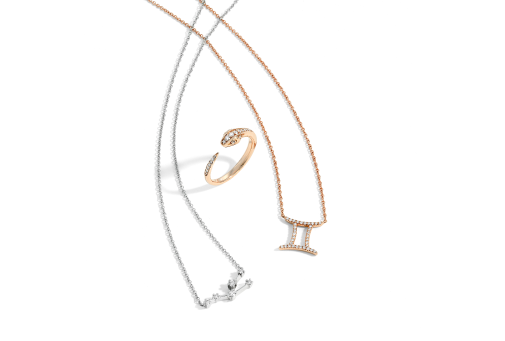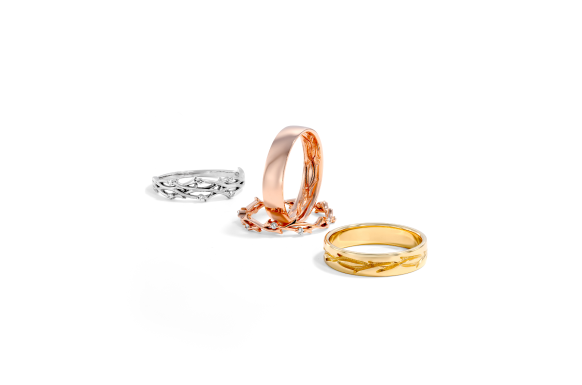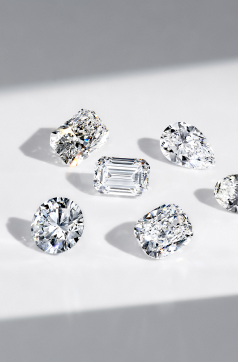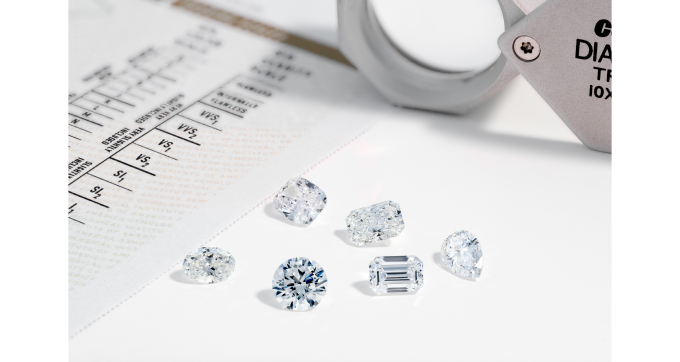Diamond alternatives have come a long way since the days of cubic zirconia. Dazzling options like moissanite and morganite mean you can snag a beautiful engagement ring without breaking the bank. Score!
Do you prefer a soft, feminine look? Morganite’s baby pink color might be the perfect match for you. Are you looking for a diamond simulant that’s super affordable? Then allow us to introduce you to moissanite: brilliant, clear as day, and ready to shine.
Are you team morganite or team moissanite? Let’s take a deeper look at these two gemstones and find out!
Why choose a diamond alternative?
Younger generations (we’re looking at you, millennials!) have started to popularize diamond alternatives. People are changing the way they spend, and lots of millennials opt to save on a ring and splurge on a honeymoon or home. Morganite and moissanite are more affordable than diamonds, so demand for them is climbing.
Diamond alternatives are also attractive options for people looking for ethical gemstones. It’s no secret that the natural diamond industry sometimes comes under fire for its sourcing methods. Choosing a diamond alternative means you don’t have to sweat how your stone was sourced.
Many companies now actually do sell ethically sourced diamonds, as well as lab-grown diamonds. But, diamond alternatives like morganite and moissanite are lab grown, so they’re guaranteed to be ethically sourced. And, they’re more affordable.
Ditching diamonds for moissanite and morganite
Whether diamonds are mined or lab grown, they still come with a hefty price tag. Morganite and moissanite come to the rescue at a fraction of what diamonds cost. These stones are rising stars in the world of engagement rings, and make unique, trendy center stones.
Think diamonds are the rarest of them all? Think again - both morganite and moissanite are actually rarer in nature than diamonds. These two gems are so hard to find in nature that lab grown morganite and moissanite are the norm, not the exception.
So, what exactly are these diamond alternatives? Morganite is a diamond simulant that essentially looks like a pink diamond. Moissanite, on the other hand, looks extremely similar to a diamond but has more fire. It’s also one of the hardest gemstones around, and its lack of color makes it a super convincing alternative to diamonds.
Pretty in pink or crystal clear?
Whether you’re looking for a colorful statement stone or a dead ringer for a diamond, morganite and moissanite both work. Morganite comes in a range of pink shades, from orange-pink to pale baby pink. Fifty shades of pink, anyone? In general, the more pink the morganite, the more desirable it is. Orange tones aren’t as popular. Deep, ideal cut morganite stones have more pink tones; shallow cuts have more orange hues. Go deep!
Moissanite tends to be clear, and the best quality stones can be super hard to tell apart from colorless diamonds. Colorless moissanite has no warmth, is clear, and is highly sought after thanks to how similar it looks to a diamond. At Keyzar, we offer crystal clear, perfectly cut moissanite with the “crushed ice” look that makes it look even more like a sparkly diamond.
Moissanite stones are also available in a range of colors like blue, yellow, and green. If you’re into the color diamond look but not into the price tag, colored moissanite makes a great alternative. Contact us if you’re looking for colored moissanite!
Is it tough enough?
You’ve probably heard the phrase, “hard as a rock” - but diamonds are even harder. Diamonds are widely known as extremely hard, durable stones. This tough gem scores a 10 on the Mohs scale for hardness.
Since diamonds can handle rough and tumble, they’re a safe choice for everyday wear. That’s part of why they’re so popular for engagement rings. How do morganite and moissanite stack up against this heavy hitter?
Morganite is less durable than a diamond, and scores between 7.8 and 8 on the Mohs hardness scale. Even though it scores lower, it’s still pretty scratch resistant and is suitable for daily wear.
You do have to be a little more careful with morganite, though - it can break under forceful impact. Morganite's signature pink color can also be affected by chemicals, so avoid exposure to hydrofluoric acid.
Moissanite is ultra durable - it scores a 9.5 on the Mohs hardness scale, right behind diamonds. It’s not easily susceptible to chipping or damage, so it’s perfect for daily wear. Moissanite even one-ups diamonds in one category: it can actually tolerate even higher temperatures than diamonds, and holds up well against light and chemicals.
Show us what you’re made of
Morganite and moissanite are made of different natural materials, and one of them comes from literally out of this world! Their different composition makes them different in appearance and hardness. Morganite is a variety of beryl, which is a rare but naturally occurring gemstone. Beryl mines do exist, but it’s so rare that it’s mostly lab grown. Morganite also has some pretty famous relatives - emerald and aquamarine are also varieties of beryl.
Moissanite is made of silicon carbide, and was first discovered at a meteor crash site in Arizona. This “space gem,” like morganite, is so rare that most moissanite on the market is lab created.
How expensive is morganite vs moissanite?
If you’re opting for a diamond alternative to save money, morganite and moissanite are both more affordable than diamonds. The price per carat of both stones is lower than even lab created diamonds.
Morganite usually costs about three hundred dollars per carat. Compared with a high quality diamond that can cost thousands of dollars per carat, morganite is quite affordable. But, morganite is more likely to scratch, and its pink coloration means it doesn’t look like a diamond.
Not to be outdone, moissanite is also more affordable than diamonds. Since moissanite costs so much less cost per carat compared to diamonds, you can get a much larger stone while spending less. Our customers always “complain” that people think they’re a lot richer than they actually are, because their moissanite rings look so much like diamonds!
Conclusion
When it comes down to it, morganite and moissanite are both more affordable options than diamonds. But, moissanite looks more like a diamond thanks to its clear coloration and sparkle. If you’re looking for the most convincing diamond alternative, moissanite will shine as the center stone of your engagement ring.






